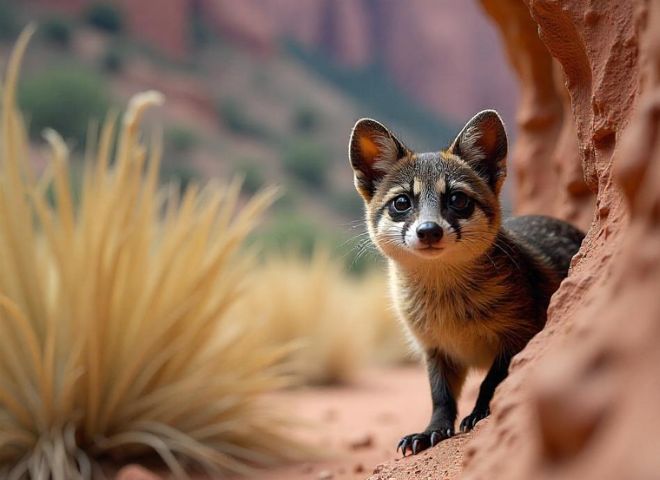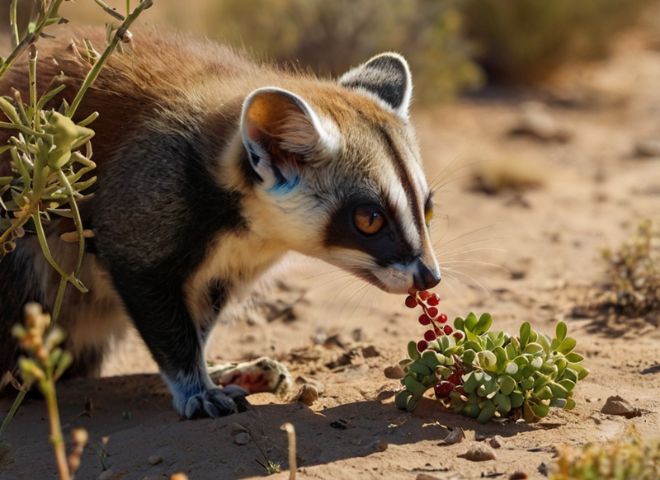Related to animals in the desert, most people think of wolf or snake bells. Discover the intriguing ringtail that is hard to understand in Arizona. Although it is Arizona’s mammals, in Arizona is still a mystery for many people and tourists. In this article, we will discover everything you need to know about this hard-to-grasp creature.

What is Ringtail?
Despite its nickname ‘small cat,’ the ringtail is distinctly different from cats. Its name is derived from its long striped tail, which belongs to the Raccoon family. The name in Arizona is small, usually weighing under 3 pounds, and has big eyes suitable for the night lifestyle. The ring is extremely agile, often compared to a monkey because of the ability to climb on rocks and trees easily.

Where Do Ringtails Live? Habitat in Arizona
Ringtail in Arizona makes his house in Da Da Gorge, desert cliffs, and even old barns or buildings. Due to their nocturnal and timid nature, individuals seldom catch a glimpse of them. However, if you are lucky, you can locate one on a night walk near the canyon or a stream. Special, they need places to hide during the day, such as the rocks, which makes Arizona’s landscape ideal for their survival.

How Do They Behave? Observing in Arizona
Related to behaviour, Ringtail is lonely and very territory. It marks its area with a perfume and often avoids other animals, except in the partner season. Beans in Arizona is also a great climber, using long tails for its balance and flexible joints to lower the cliffs in the mind.

What Do They Eat? Diet in Arizona
One of the most appealing aspects of Ringtail in Arizona is its diet. As a minivores, rings eat everything, insects and rodents with berries and fruits. This diverse diet helps them exist in difficult desert environment. Other, their appetite for harmful species such as mice and insects makes them very useful to control unwanted organisms.

Benefits and drawbacks of Ringtail in Arizona
Benefits
- Insect -eating rings, rodents and small parasites, helping to maintain a balance in the environment.
- They are shy and avoid contact with humans, which makes them unable to cause problems.
- The rich contribute to a healthy Desert ecosystem by both a predator and prey.
- Unlike Rawlywashers or Skuffs, rarely causes material damage.
- Rich people encourage cognitive efforts about wildlife and conservation.
Drawbacks
- Their secret and night behaviour means that most people never appreciate them.
- To search for food or shelter, the rich can sneak into the reservoir or attic.
- Their presence can attract larger predators such as owls or red lynxes near the home.
- Some people confuse them with panda or wild cats and try to eliminate them.
- Although cute, they are wildlife and cannot be tamed safely or legally.
Why Is the Ringtail Important?
Because they are both predators and prey, wines in Arizona play an important role in maintaining ecological balance. They help control the complex of insects and rodents while serving as food for larger predators such as owls and red lynx and the Gray Fox . Thus, the protection of the Ringtail is imperative for fostering a healthy and balanced desert ecosystem in Arizona.
Conclusion
Ringtail in Arizona is an essential but forgotten part of the desert ecosystem. Although it is not as famous as Roadrunner or scared like a bell snake, but ringtail keeps it with charm, agility and charm. If you find someone, consider yourself lucky – you just see one of the most secret treasures in Arizona.
Frequently asked questions
Q: Is the ringtail dangerous?
Arizona’s ringtails are reclusive and avoid people. Only when there is a corner does he pose a threat.
Q: Are ringtails suitable for keeping as pets?
No. While some adolescents have done so in the past, rich people are wildlife and should be in their natural living environment.
Q: Are ringtails in Arizona considered endangered?
Lucky, no. Beans in Arizona is not in danger, but destroying the habitat may cause risks in the future.
Q: What should I do if I see a ringtail?
Take advantage of a rare view, take photos remotely, and do not try to feed it or touch it.
